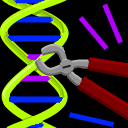Rerun: Dan Brown’s “Inferno”: Good Plot, Bad Science
I’m thrilled that DNA Science made the top 15 PLOS blog posts of 2015, but a little surprised that the entry was for analysis of the genetic accuracy of the TV series Wayward Pines. Then I remembered that the top post, with 40,166 unique visitors, was my review of Dan Brown’s Inferno. Because the film version of Inferno is coming out in October 2016, I thought I’d rerun my analysis New Year’s Eve. My serious post for the week is at Rare Disease Report, about using CRISPR/Cas9 to treat Duchenne muscular dystrophy in mice — some good news following a recent clinical trial setback. On to Dan Brown.
Originally posted January 9, 2014:
When Dan Brown’s latest novel, Inferno, was published last summer, several people insisted I read it – because it’s about an insane geneticist. So when my local library asked me to give a talk about a book with genetics in the plot, I chose Inferno.
Dan Brown gets an A, as usual, for writing style and pace. But this time, the plot is a stretch, and he gets an F in genetics.
I learned that scientific accuracy shouldn’t get in the way of telling a good story at the Catalyst Workshop at the American Film Institute, where every summer a dozen scientists learn screenwriting from the pros. I went in 2005. After a week of dissecting The Day After Tomorrow, an exciting end-of-the-world thriller that seems all too possible with the recent crazy weather, we all concluded, as our instructors had said from the outset, that in entertainment, scientific accuracy just doesn’t matter. So it’s okay if the magnetic poles suddenly switch and a person recovers from septicemia in a few hours with one shot of penicillin.
 As anyone who’s read Dan Brown’s The Da Vinci Code and the Lost Symbol knows, protagonist Robert Langdon is a Harvard professor specializing in symbology who is summoned for emergencies that require him to rocket through Europe running from bad guys and heading off global disasters, while following clues and cues in art. He’s always called “Professor.” Many of my friends are professors, and I’m an adjunct, and we don’t call ourselves Professor. Maybe it’s different in the art world.
As anyone who’s read Dan Brown’s The Da Vinci Code and the Lost Symbol knows, protagonist Robert Langdon is a Harvard professor specializing in symbology who is summoned for emergencies that require him to rocket through Europe running from bad guys and heading off global disasters, while following clues and cues in art. He’s always called “Professor.” Many of my friends are professors, and I’m an adjunct, and we don’t call ourselves Professor. Maybe it’s different in the art world.
A MASH-UP OF 24, THE ANDROMEDA STRAIN, AND DALLAS
Robert Langdon (aka Tom Hanks) evokes Jack Bauer (aka Keifer Sutherland) of the TV series 24, in which incredible action unfolded over the course of a day. Inferno also takes place during a very busy day.
Due to the time pressure, Langdon’s metabolism is perpetually in high gear. Within a few pages, he was frozen in utter disbelief, startled, stunned, chilled, transfixed, he reeled, and did several double takes. I became concerned about his health when, in short order, his mouth fell open, heart raced, hair on his neck bristled, his pulse quickened, he sat speechless, audibly gasped, and barely breathed. Later on, his eyes went wide, as anyone’s would. His stomach knotted, he felt a visceral tremor, and his insides reverberated. Much of this happened whilst learning perfectly ordinary things about viruses, like the fact that they can nestle into our DNA.
Would my metabolism go into overdrive if I studied art? (Another of Brown’s very effective techniques is to put thoughts in italics.)
Poor RL (not me, Langdon).
Because the villain is a warped geneticist letting loose a human-gamete-eating virus, Inferno is also reminiscent of Contagion, Outbreak, and The Andromeda Strain, the best of the genre. Actually The Hot Zone was best because it was true.
 Inferno opens with a frighteningly vivid dream sequence based on artists’ depictions of Dante’s experiences in hell. Then RL awakens in a hospital room in Florence, tended to by a woman with a blond ponytail, Dr. Sienna Brooks, who gradually becomes just “Sienna” or “Ms. Brooks” while the other notables retain their titles. An obsession with feminine follicles emerges when we encounter a threatening “spike-haired woman” and the silver-haired head of the World Health Organization.
Inferno opens with a frighteningly vivid dream sequence based on artists’ depictions of Dante’s experiences in hell. Then RL awakens in a hospital room in Florence, tended to by a woman with a blond ponytail, Dr. Sienna Brooks, who gradually becomes just “Sienna” or “Ms. Brooks” while the other notables retain their titles. An obsession with feminine follicles emerges when we encounter a threatening “spike-haired woman” and the silver-haired head of the World Health Organization.
In addition to taking elements from 24 and the outbreak genre, towards the end of the book, when the set-up is revealed, I was suddenly catapulted back to 1986 when Pam Ewing sees her supposedly dead husband Bobby in the shower on the TV show Dallas. Instead of introducing a surprise twin after actor Patrick Duffy quit and his character was offed and then he decided to return, the writers had Pam realize that her hubby’s death had been a dream, and the entire previous season, all 31 episodes, had never happened. (See Bobby Ewing in the Shower: An Epic Storytelling Gaffe and more recently the end to The Man in the High Castle on Amazon Prime.)
Inferno has that feel of wasted reader time, especially when one is awaiting scientific details and explanations that never come.
THE PLOT
The plot point that sets everything into motion is when “genetic engineer” Bertram Zobrist explains the exploding human population problem to WHO’s silver-haired leader Dr. Elizabeth Sinskey. I assume Dr. Z has a PhD — he’s described as a “genius of genetics,” whatever that means.
(An aside: I hate the term “genetic engineering.” It’s a media invention. You can’t major in it, and it isn’t offered in engineering schools. The only place I could find it as an academic field is in a few online programs from outside the U.S., and in the name of a publication I used to write for. However, Dr. Brooks declares, “The world of genetic engineering is one I’ve inhabited … for many years… Perhaps she took the online course.)
Anyway, Dr. Sinskey doesn’t take Dr. Zobrist’s predictions seriously, perhaps because he is all gloom and doom with nary a mention of the “carrying capacity,” the leveling off of population expansion rather than annihilation of humanity.
So Dr. Z. hires a shady organization called the Consortium, led by the shady “provost,” which is headquartered on a big yacht full of mysterious bad guys and the spiky-haired woman. The Consortium is to shield him for a year as he invents and plants a viral plague to control population growth, without asking any questions.

Dr. Zobrist, it turns out, is a big Dante fan, and Dante died of bubonic plague. This is when I became intensely interested, having been criticized for writing an article for The Scientist on the plague genome, with a sidebar on using it as a bioweapon, just weeks after 9/11.
A plague story! Alas, Inferno evokes “plague” rather loosely. Somehow the plague bacterium that felled Dante along with a third of Europe during the Middle Ages morphs into an airborne viral infection in the novel. It’s almost as if Dan Brown doesn’t know the difference between a bacterium and a virus.
Dr. Sinskey taps RL to find the bioweapon, because clues lurk in Sandro Botticelli’s depiction of Dante’s Inferno and other works. Snippets of the puzzle struggle to the surface of Langdon’s consciousness as he and Dr. Ponytail schlep through the art and artifacts of Florence. It would have helped the good Professor immensely, and saved at least 100 pages, if he owned a smartphone and didn’t have to bug tourists to use their Internet connections to look up the parts of Dante’s tome that he can’t recall.
Meanwhile, European CDC guys join the chase. Here is a good website for artistic clues and maps, if you’re like me and are just waiting for the science to show up.
 The plot detours to a few red herrings, which are jarring and manipulative. Dr. Brooks doesn’t really have a ponytail, it’s a wig; she’s bald from the lingering stress of having been raped. Dr. Sinskey isn’t really being drugged against her will when RL spies her slumped over in the back of a car; she has a barf disease that requires sedation. And finally, imposter Jonathan Ferris doesn’t have plague, he has a latex allergy from wearing a mask to play a character that appears earlier in the book. Also, good guys are bad guys and vice versa.
The plot detours to a few red herrings, which are jarring and manipulative. Dr. Brooks doesn’t really have a ponytail, it’s a wig; she’s bald from the lingering stress of having been raped. Dr. Sinskey isn’t really being drugged against her will when RL spies her slumped over in the back of a car; she has a barf disease that requires sedation. And finally, imposter Jonathan Ferris doesn’t have plague, he has a latex allergy from wearing a mask to play a character that appears earlier in the book. Also, good guys are bad guys and vice versa.
SENSELESS SCIENCE
Early foreshadowing of superficial science is on page 36, where the author confuses cerebellum with cerebrum, and PET scans with CT scans. And he makes the classic trio of errors later on — human cell walls (animals are the only types of organisms without cell walls), “a bacteria,” and each of us having our own genetic codes.
 But the worst illogic comes towards the end.
But the worst illogic comes towards the end.
Tethered beneath the surface of a gloomy underground lagoon, not in Italy, lies a bag filled with yellowish-brown goop that holds enough of a mysterious virus to render much of humanity infertile – somehow. The investigators have set up PCR devices throughout the area, which all start blinking red to indicate detection of the “never-before-seen viral pathogen.” What did they use for primers? You can’t amplify a nucleic acid using the polymerase chain reaction without having a smidgeon of DNA or RNA from known pathogens.
Another error is one of omission. Sprinkled throughout the book are mentions of germline manipulation; Dr. Z. is a “germline genetic engineer.” We learn that fooling around with a germline is evil and powerful, but not exactly what it is. And herein lies the confusion. To a biologist, “germ” means “germ cell,” as in precursors to sperm and eggs. To a normal person, however, “germ” means a pathogen, such as a bacterium or virus. So it isn’t clear that a germline manipulation actually means changing future generations. And germline manipulation won’t even be necessary, because if the viruses work, there won’t be another generation. They need only obliterate existing sperm and eggs.
 Practically, I had difficulty envisioning how the airborne viruses would get into gametes of the hundreds of people pushing to escape the lagoon, like Christmas shoppers barging into Wal-Mart. Germline manipulation isn’t easy. It’s banned in people for ethical reasons, although CRISPR/Cas9 may challenge that. Germline manipulation is used, however, to create animal models of human disease.
Practically, I had difficulty envisioning how the airborne viruses would get into gametes of the hundreds of people pushing to escape the lagoon, like Christmas shoppers barging into Wal-Mart. Germline manipulation isn’t easy. It’s banned in people for ethical reasons, although CRISPR/Cas9 may challenge that. Germline manipulation is used, however, to create animal models of human disease.
Fortunately, Dr Z’s scourge won’t drive humanity to extinction, because a few people are randomly immune to the virus. Random? How does that work? Wouldn’t a resistance genotype be quite specific, invented by those genetic engineers, and not random?
Most vexing was the unfamiliarity with the ways of viruses. For example, the supposed experts in Inferno use the term “vector” as if it is a type of virus, like a herpesvirus.
 “Vector” is a general term that means a vehicle to transfer DNA. Proclaims Dr. Brooks, “A vector virus … rather than killing its host cell … inserts a piece of predetermined DNA into that cell, essentially modifying the cell’s genome.” I don’t know what predetermined means (viruses can’t think), and a virus inserting into a chromosome, a phenomenon called lysogeny, doesn’t modify a DNA sequence, it adds to it. And it’s normal. Our chromosomes carry loads of viral sequences.
“Vector” is a general term that means a vehicle to transfer DNA. Proclaims Dr. Brooks, “A vector virus … rather than killing its host cell … inserts a piece of predetermined DNA into that cell, essentially modifying the cell’s genome.” I don’t know what predetermined means (viruses can’t think), and a virus inserting into a chromosome, a phenomenon called lysogeny, doesn’t modify a DNA sequence, it adds to it. And it’s normal. Our chromosomes carry loads of viral sequences.
Still, “Langdon struggled to grasp her meaning. This virus changes our DNA?”
Alas Drs. Brooks and Sinskey can’t fathom how to counter the virus, other than making another virus to fight it. Antisense? RNAi? The aforementioned CRISPR/Cas9, invented shortly before the book came out? In fact, biotechnologies to silence genes have been around for decades. One paragraph describes gene therapy, not calling it that, and claiming it’s new. It isn’t. The first clinical trial was in 1990.

The lack of savvy about viruses may be due to a Dana Scully effect, the assumption that any medical doctor is also a scientist. (She was from the X-Files, an MD constantly calling herself a scientist.) The three technical experts Dan Brown thanks in the preface are MDs – two are infectious disease specialists, the third I couldn’t find, and none belong to the American Society of Human Genetics. He needed to run the genetics parts by a geneticist. I would have happily done it.
Evolution is also handled oddly, although RL claims to be skilled in matters Darwinian. He and the docs confuse natural selection and survival of the fittest, which deal with reproductive success, with genetic enhancement to “advance the species” and “create better humans.” I think Brown means that those who survive to have successful sex after the viral scourge will then, either by the viral DNA or some new genetic treatment, churn out kids who get high SAT scores and humanity will be saved. The long-awaited explanation of the science is disappointingly vacuous hand-waving — throw out a bunch of jargon to make it sound like it makes sense. It doesn’t.
Even the conclusions in plain English are vague to the point of meaninglessness: “He had unlocked the evolutionary process and given humankind the ability to redefine our species in broad, sweeping strokes.” From a virus with a predilection for gametes?
Finally, the fake-ponytailed Dr. Brooks, flummoxed by the ins and outs of viruses, assures us that “the human genome is an extremely delicate structure … a house of cards.” Then how can engineers manipulate it with a whiff of a virus?
 It’s great that a novelist as acclaimed as Dan Brown would base a plotline around genetics. But he squandered an opportunity to teach the public about the good that geneticists do. Why not a subplot of a sick kid? A family that uses the terrifying “germline genetic engineering” to vanquish a terrible genetic disease?
It’s great that a novelist as acclaimed as Dan Brown would base a plotline around genetics. But he squandered an opportunity to teach the public about the good that geneticists do. Why not a subplot of a sick kid? A family that uses the terrifying “germline genetic engineering” to vanquish a terrible genetic disease?
The last thing our science-phobic world needs is another mad scientist – even a fictional one.
Stay tuned for my review (if relevant) of The X-Files reboot, coming in January 2016, if it includes DNA. The truth is out there!

